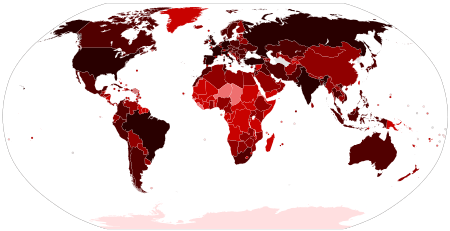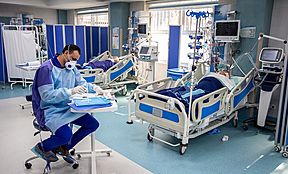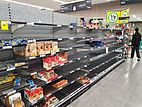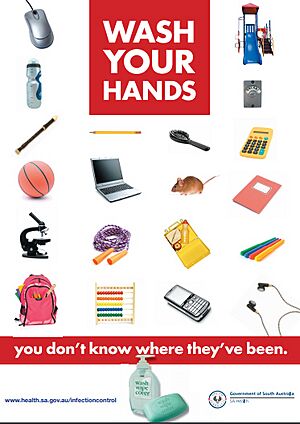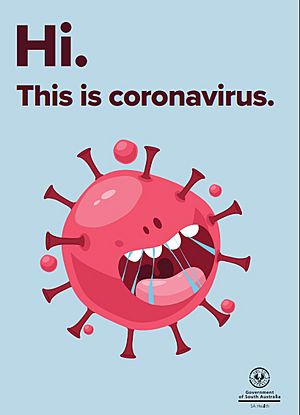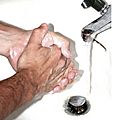2019–20 coronavirus pandemic facts for kids
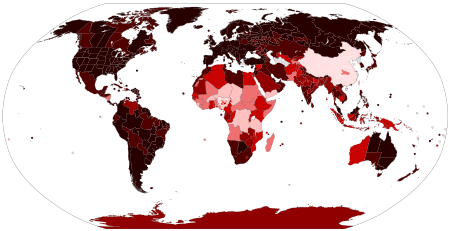
|
|||||||
|
|||||||
|
(clockwise from top)
|
|||||||
| Disease | Coronavirus disease 2019 (COVID-19) | ||||||
|---|---|---|---|---|---|---|---|
| Virus strain | Severe acute respiratory syndrome coronavirus 2 (SARS-CoV-2) |
||||||
| Location | Worldwide (list of locations) | ||||||
| Date | Nov / Dec 2019 – ongoing (6 years, 1 month and 1 week) |
||||||
| Confirmed cases | 1,196,553 | ||||||
| Recovered | 246,108 | ||||||
|
Deaths
|
64,549 | ||||||
|
Territories
|
209 | ||||||
The 2019–20 coronavirus pandemic was a worldwide outbreak of a sickness called COVID-19. It was caused by a new virus named SARS-CoV-2. The first cases were found in Wuhan, China, in December 2019. The World Health Organization (WHO) said it was a pandemic on March 11, 2020. This means the disease had spread across many countries and continents.
The virus usually spreads when an infected person coughs or sneezes. Tiny drops from their lungs can carry the virus to others nearby. It can also spread if someone touches a surface with the virus on it, then touches their face.
To help stop the virus from spreading, people were encouraged to wash their hands often. They also needed to cover their mouths when coughing. Keeping a safe distance from others, especially sick people, was important. If someone thought they were infected, they needed to stay home.
The virus likely came from a type of coronavirus found in Bats. It might have then infected pangolins. The virus then changed, allowing it to infect humans.
Contents
Understanding COVID-19 Symptoms
Common signs of COVID-19 include a fever, a cough, and trouble breathing. Sometimes, people could get more serious problems like pneumonia. At the time, there was no special medicine or vaccine to cure COVID-19. Doctors mainly gave patients care to help them feel better.
How Kids Can Help During a Pandemic
Adults work hard to keep everyone safe during a pandemic. Kids can also help reduce the spread of viruses like COVID-19. Here are some simple but important things you can do:
- Wash your hands properly: Use plenty of soap and rub your hands together. Make sure to clean all your fingers, under your fingernails, and between your fingers. Sing a short song like "Happy Birthday" twice to make sure you wash for about 20 seconds.
- Cover your coughs and sneezes: Always cover your mouth and nose with your elbow or a tissue. Throw the tissue away right after.
- Keep your distance: Try to stay a safe distance from other people. This is especially important if someone looks unwell.
- Avoid touching your face: Try not to rub your eyes or nose, or put your hands in your mouth. This helps stop germs from entering your body.
If you have to stay home, there are many fun activities you can do.
Helpful Resources for Kids
There is a great Coronavirus book for kids by the South Australian government. It explains what the coronavirus is and how kids can help stop its spread.
Other Related Pages
- Isolation (health care)
- Homeschooling during coronavirus 2020
- Easter Egg Hunt With Social Distancing in 2020
- N95 mask
Images for kids
-
Deceased in a refrigerated "mobile morgue" outside a hospital in Hackensack, New Jersey, U.S., in April 2020.
-
Gravediggers wearing protection against contamination bury the body of a man suspected of having died of COVID-19 in the cemetery of Vila Alpina, east side of São Paulo, in April 2020.
-
A nurse at McMurdo Station sets up the polymerase chain reaction (PCR) testing equipment, in September 2020.
-
Goals of mitigation include delaying and reducing peak burden on healthcare (flattening the curve) and lessening overall cases and health impact. Moreover, progressively greater increases in healthcare capacity (raising the line) such as by increasing bed count, personnel, and equipment, help to meet increased demand.
-
A highway sign discouraging travel in Toronto in March 2020
-
A temporary hospital constructed in Wuhan in February 2020.
-
Vaccinations at a retirement home in Gijón, Spain, in December 2020.
-
The hospital ship USNS Comfort arrives in Manhattan on 30 March 2020.
-
US Air Force personnel unload a C-17 aircraft carrying medical supplies in Niamey, Niger, in April 2020.
-
Ukraine evacuates Ukrainian and foreign citizens from Wuhan, China.
-
World Health Organization representatives holding joint meeting with Tehran city administrators in March 2020.
-
An American Catholic military chaplain prepares for a live-streamed Mass in an empty chapel at Offutt Air Force Base in March 2020.
-
Students take end-of-year exams in Tabriz, Iran, during the pandemic.
-
The "Wee Annie" statue in Gourock, Scotland, was given a face mask during the pandemic.
See also
 In Spanish: Pandemia de COVID-19 para niños
In Spanish: Pandemia de COVID-19 para niños


